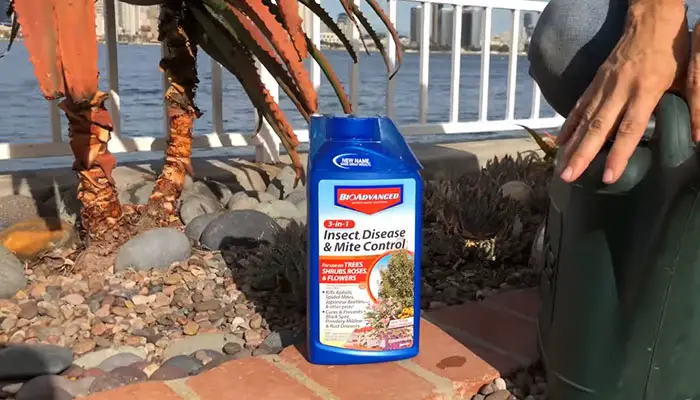The “Most Unwanted Guest” award goes to Powdery Mildew. Yup, these ones are definitely unwanted but that’s only the bad part. The worst part is, it visits a lot.
Anyway, most gardeners get tense seeing those white dust, but this time let’s put some tension on the guest too. So, what’s the plan? The plan is very simple. If the host is not welcoming enough, guests won’t come.
Hence, how to make a vulnerable environment for Powdery Mildew? That’s simple too. Use the ideal fungicide to prevent or cure. That way, either Powdery Mildew won’t show up, or it will die.
But before starting, we should know what is the best treatment for powdery mildew? Well, for a 100% perfect treatment, choose any fungicide that uses Copper Octanoate, Myclobutanil, Chlorothalonil, Azoxystrobin, Neem Oil, etc as the Active Ingredient.
So, let’s do some fungicide picking & start the battle. My article will provide you a well-researched review of the 10 best fungicides that you can get to kick out Powdery Mildew & some other relative information.
However, let’s dive into it.
Top 10 Fungicide For Powdery Mildew- Comparisons
| Fungicide | Active Ingredient | Form | Type | Price |
|---|---|---|---|---|
| Bonide Fungicide | Copper Octanoate | Concentrate | Organic | |
| Spectracide Immunox Fungicide | Myclobutanil | Concentrate | Synthetic | |
| BIOADVANCED 3-In Fungicide | Tebuconazole | Ready-To-Use/Concentrate | Synthetic | |
| Southern Ag Fungicide | Copper Diammonia Diacetate Complex | Concentrate | Organic | |
| Garden Safe Brand Fungicide | Clarified Hydrophobic Extract of Neem Oil | Ready-To-Use | Organic | |
| Bonide Fungal Disease Control | Chlorothalonil | Ready-To-Use | Organic | |
| Monterey Fungicide | Bacillus amyloliquefaciens | Concentrate | Organic | |
| Dr. Earth Fungicide | Rosemary Oil, Clove Oil, Peppermint Oil | Ready-To-Use/Concentrate | Organic | |
| Safer Garden Fungicide | Sulfur | Concentrate | Organic | |
| Scotts DiseaseEx Lawn Fungicide | Azoxystrobin | Granular | Synthetic |
Top 10 Fungicide For Powdery Mildew- Reviews
1. Bonide Copper Fungicide
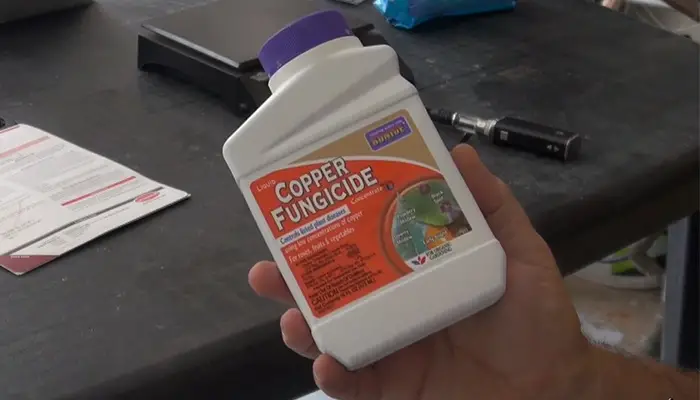
My very first recommendation is a well-received front-line defender of Powdery Mildew. By “Front-line defender,” I have meant that it is more of a preventive fertilizer than a curative one. You use such types of fungicides before the fungal attack or just after the symptoms break out.
However, I present you with an effective copper fungicide of the BONIDE brand. And now, it’s time to put an eye on the details-
Active Ingredient
Fungicides are mainly a formulation of Active Ingredients & Inert Matters, where the Active Ingredient is the prime concern. The rest of the Inert Matters work for the better motion of the Active Ingredient.
This Copper Fungicide contains 10% Copper Soap or Copper Octanoate(1.8% Metallic Copper) as the Active Ingredient.
Mode of Action
Bonide Copper Fungicide is a preventive fungicide that works through a contact mode of action. In this process, after foliar spraying, the fungicide kills the fungus that is present on the surface of leaves, stems, or buds.
Interestingly, Fungi that cause Powdery Mildew reside at the surface of the leaves mostly. Though they uptake nutrients & water by inserting filaments inside the leaf tissue, once the fungus is dead, so do the filaments.
Since contact fungicides can’t defend against fungus from the inside of tissues, it is better to remove already infected parts & destroy them. Now, you may ask, how exactly does this fungicide kill fungus? Well, that’s when the active ingredient starts working. Copper Octanoate eliminates fungus by denaturing its cell membrane & internal enzyme activity. Thus the fungus walks gradually toward death.
Key Features
This fungicide is approved for organic gardening. Therefore, if you are unwilling to use a synthetic chemical on your plants, it can be a good choice.
Moreover, Powdery Mildew literally attacks every type of plant-like Fruits, flowers, Veggies, Vines, etc. The good news is, this fungicide can prevent Powdery Mildew, Downy Mildew, Black Spots, Early Blight, Rust & Rot of vegetables, nuts, herbs, ornamentals & even turf.
Additionally, due to its safe organic nature, Bonide copper fungicide can be applied both in the growing & dormant seasons of the plant. And with all these features, I think Bonide Copper Fungicide is the most effective copper fungicide for Powdery Mildew.
Applying Procedure
Copper Fungicide is a non-selective spray. That means, if you apply it with an overdose, it can hamper healthy leaves, stems & even soil. Therefore, read the label first & then apply accordingly.
Generally, mix 0.5 to 2.0 ounces of this concentrated fluid with 1 gallon of water. After that, spray over & under the affected leaves thoroughly & repeat after every 10 days.
2. Spectracide Immunox Multi-Purpose Fungicide Spray
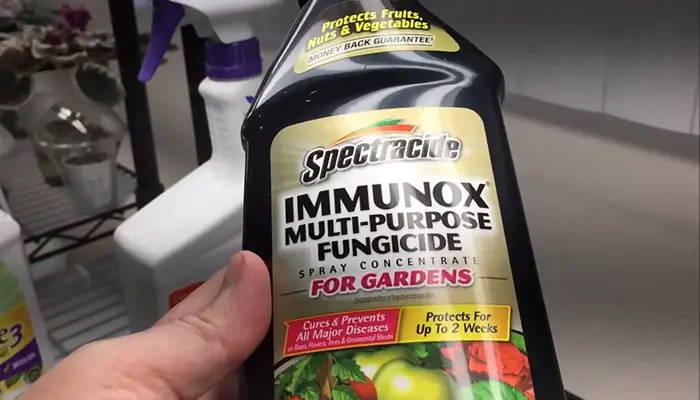
Spectracide Immunox Multi-Purpose Fungicide covers a wide range of fungal diseases & that’s a reason why this product is widely accepted. Let’s check out the other reasons to use it against Powdery Mildew.
Active Ingredient
“Myclobutanil”- a prominent chemical known for its efficient antifungal nature. This pesticide contains 1.55% of it as an Active Ingredient.
Using this Active Ingredient is directly related to the Multi-Purpose nature of this Fungicide. I am going to discuss this in the “Key Features,” & I am sure, after that, you will treat this product as the best antifungal spray of plants affected by Powdery Mildew.
Mode of Action
It is a Systemic Fungicide. Now, what are Systemic Fungicides? After spraying, some fungicides get absorbed by the plant tissue, scraping internal fungal spreading & preventing the further attack. Thereby, these are the fungicides that not only prevent but also cure the disease.
Now, let me tell you briefly what happens after spraying the pesticide. Next to applying, it takes a little time to get absorbed. After entering the plant tissue, Myclobutanil inhibits the synthesis of Ergosterol- a fungal cell membrane sterol that controls the fluidity & permeability of the cell. Thus this fungicide disrupts the fungal body cells & kills them eventually.
Key Features
Spectracide Immunox is a multi-purpose fungicide because you can use this fertilizer for your lawns, fruits, vegetables, berries & flowers. Including brown patches, powdery mildew, black spot, rust, blights, leaf spot, mold & scabs, this pesticide can cure any fungal attack on your garden plants like pumpkins, roses, grapes, ninebark, tomato, cucurbits, hydrangeas, crepe myrtle, etc.
Additionally, its systemic nature enables it to get absorbed. So, once dried, rain won’t be able to cause washing away. Plus, this unique action mode keeps the plant safe for at least 2 weeks from any fungal attack.
Applying Procedure
The application rate differs according to the type of plant. For example, maximum fruits & nuts require the following mixing ratio-
½ fl oz of Spectracide Immunox Multi-Purpose Fungicide Spray Concentrate for Gardens per 1 gallon of water. Once the mixture is prepared, apply uniformly to all parts of the tree & repeat every ten days.
3. BIO-ADVANCED 3-In-1 Insecticide Fungicide Miticide
BIO-ADVANCED is one of the supreme consumer lawn and garden brands in the United States. Their innovative & science-based formulas are unmatched in the pesticide industry. Well, why won’t that be? When the same packet takes care of insects, fungi & mites, it is definitely paramount.
Active Ingredient
It is a 3 in 1 fungicide. It contains 0.012% Imidacloprid for insect control, 0.014% Tau-Fluvalinate for mite control & 0.015% Tebuconazole for fungal control.
Mode of Action
Bio advanced 3 in 1 works in a systemic mode of action. That means, first it gets absorbed, kills the existing fungus & then makes a shield for further prevention. Now let’s talk about the active ingredients.
0.012% Imidacloprid is the insect killer here. It disrupts the central nervous system of the insect which results in paralysis & eventual death. Specifically for mite control, 0.014% Tau-Fluvalinate is present. This chemical works in the same manner by overstimulating the central nervous system.
And finally, Tebuconazole is the ultimate fungus killer. What it does is interfere with fungal spore germination & ergosterol production. And because of that, fungi lose the rapid spreading & also the cell structure. Thus, Tebuconazole leads the fungus toward destruction.
Key Features
This is a specially formulated fungicide for roses, flowers, and shrubs & guarantees 100% rainproof protection for up to 1 month. However, it cures & prevents nearly 7 types of fungal diseases including anthracnose, black spot, leaf spot, petal blight, powdery mildew, rust, and scab.
Additionally, Bio-advanced fungicide prevents listed insect, mite, or disease infestations & also controls them at their first appearance but make sure that you are using it only for non-edible plants.
There is a list of 15 insects that can be controlled & prevented by this product. Here’s a glimpse- Aphids, Beetles, Earwigs, Japanese Beetles, adult, Leaf-feeding caterpillars, Leafhoppers, Leafminers, Mites, Psyllids, Spider Mites, Whiteflies, etc.
Finally, after all these features & amazing facts, I can’t think of a more perfect systemic fungicide for Powdery Mildew, can you?
Applying Procedure
It is a Ready-To-Spray fungicide. All you need to do is shake, plug in the hose & spray. If you prefer, a concentrated version is also available of this product.
4. Southern Ag Liquid Copper Fungicide
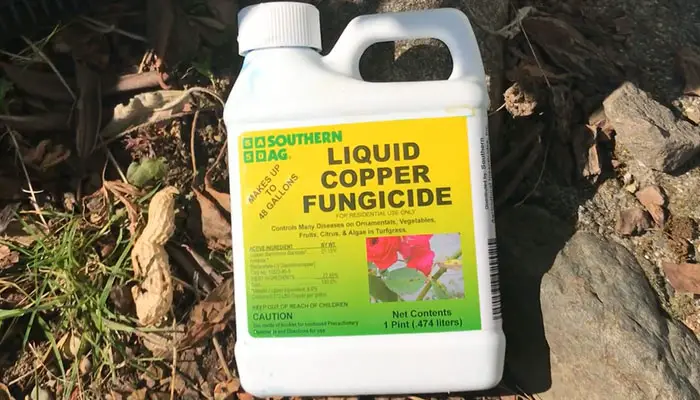
Copper fungicide strikes again. This time it is a liquid formulation of SOUTHERN AG company. Let’s check out the specialty of this fungicide-
Active Ingredient
With 8% Metallic Copper Equivalent, this fungicide includes 27.15% Copper diammonia diacetate complex as the Active Ingredient.
However, it is a thin & strong chemical with synthetic nature & interestingly, along with fungicidal potential, this compound also acts as a bactericide.
Mode of Action
It is a contact fungicide. After applying, the chemical first gets dried but doesn’t get absorbed. Fungi that cause Powdery Mildew normally dwell on the surface. The Copper active ingredient comes in contact with the fungal body, obstructs the cell membrane & causes eventual death.
Key Features
The most exclusive part is, this fungicide not only works on fungal & bacterial diseases but also clears out algae & moss from your garden.
Moreover, along with powdery mildew, this copper fungicide can prevent nearly hundreds of fungal diseases & save your fruits, vegetables & ornamental plants.
It can take care of more or less fifty flowering plants involving Bougainvillea, Dahlia, hibiscus & many more. But the list is not finished yet. There are also 11 fruit trees including apples, Avocado, Citrus, etc & 25 vegetables like Tomato, Potato, and Eggplant, etc in the list. The range is pretty wide, right?
Applying Procedure
To get rid of powdery mildew forever, apply this fungicide every 7-14 days during the season when fungal attacks are at their peak. The mixing ratio is 2 tablespoons/gallon of water.
5. Garden Safe Brand Fungicide
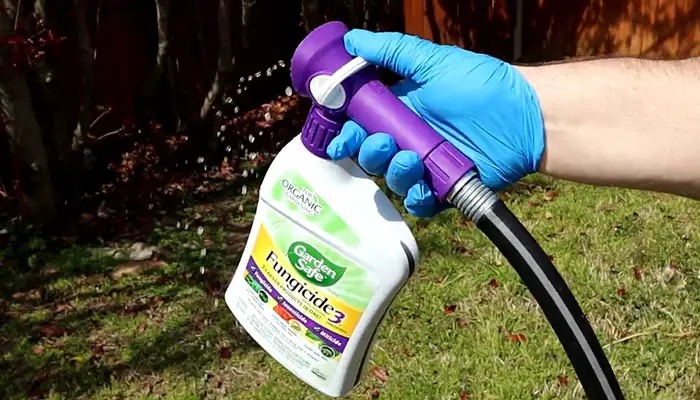
Garden Safe Brand has been delivering nature-based & botanically derived formulas since 2002. This company believes in controlling diseases without using traditional chemicals. And we don’t have any problem with that as long as the disease gets prevented & cured.
Active Ingredient
We all know about Neem oil, right? We often use it as homemade medicine for our garden plants. As neem oil is a natural insecticide, miticide & fungicide, this product has used 0.9% clarified hydrophobic extract of neem oil for fighting against all three of these problems.
Mode of Action
Clarified hydrophobic extract of neem oil is a preventive antifungal compound. It comes into contact with the fungus, insect, or mite, coats them, causes suffocation & leads to death. Therefore, it is a contact fungicide & won’t cure already infected leaves or plants. It will rather prevent further spreading of Powdery Mildew.
Key Features
You already know it is a multi-purpose fungicide that kills insects, mites & fungi. About insects, Garden Safe Fungicide kills nearly 20 insects including, whitefly, armyworms, hornworms, leafhoppers, bagworms, leafminers, psyllids, fruit flies, aphids, scales, caterpillars, midges, spider mites, etc.
Along with Powdery Mildew, you can also use it to prevent black spots, downy mildew, anthracnose, rust, botrytis, needle rust, scab, blight, and powdery mildew of roses, flowers, houseplants, ornamental trees, shrubs, fruits, nuts, and vegetables grown in your garden.
Applying Procedure
It is also a Ready-To-Spray fertilizer. Just shake properly & spray all over the plant accurately.
6. Bonide Fungal Disease Control

Fung-onil Multi-purpose Fungicide is another classic product of the Bonide brand. I have listed an organic fungicide from Bonide already but, here’s another one.
Active Ingredient
2,4,5,6-Tetrachloroisophthalonitrile. Yup, that’s the active ingredient. It is the actual chemical name of this organic compound. But you can call it by its general name “Chlorothalonil(29.60%).” This way, it is easier to pronounce.
However, the specialty of this ingredient is its broad-spectrum nature that targets a wide range of pathogens. Not only that, but it also prevents disease resistance of fungi that cause Powdery Mildew.
Mode of Action
Fung-onil is a contact fungicide. It inhibits the production of enzymes necessary for Ergosterol synthesis. You already know that Ergosterol is a major sterol of the fungus cell membrane & without it, the cell gets disrupted & eventually moves to death.
Fungi that cause Powdery Mildew remain at the surface of the leaves mostly. Since this fungicide works after getting in contact, it won’t be hard to eliminate those enemies.
Key Features
You already know about its broad-spectrum quality. But this product shows another significant mode of action & that is multiple-site action. By this, the fungicide causes harm to the pathogen in multiple ways & reduces its spreading rapidly.
Now, if we talk about its efficiency, what are the usual plants of our garden? One might say beans, tomatoes, potatoes, onions, corn, azaleas, eucalyptus, maple trees, daisies, geraniums, roses, etc, right? Now, what are the common fungal diseases of this plant? He must add- black spots, botrytis blights, anthracnose, rusts, powdery mildews, scabs, etc.
Good news, Fung-onil Multi-purpose fungicide can take care of all of these. Not only that, your lawn can be treated with this product too.
The best way to kill Powdery Mildew is to apply fungicide beforehand or just after symptoms start showing up. And, in that case, this fungicide can be your perfect choice.
Applying Procedure
There are different preparation ratios for different plants given on the product label. But generally, 1 teaspoon per gallon is used. Therefore, before applying, read it properly.
7. Monterey Complete Concentrate Fungicide

This product took my attention because of its organic nature. Keeping its OMRI approval aside, I was curious about the term “Biofungicide.” Let me tell you why I have enlisted this product in detail.
Active Ingredient
Monterey Complete Concentrate Fungicide is a bio fungicide & bactericide. 98.85% of this fungicide is a naturally occurring bacterium strain called Bacillus amyloliquefaciens strain D747. That’s why it is a bio fungicide & bactericide.
Mode of Action
It is a preventive fungicide or contact fungicide, one can say. Bacillus amyloliquefaciens is a soil-borne bacteria that creates several chemicals that inhibit fungal spore germination & spreading.
Plus it stimulates internal disease resistance & the antibiotic nature of the plant to control bacterial diseases along with Powdery Mildew.
Key Features
Interestingly, the fungicide contains a minimum of 1×10^10 colony-forming units of bacteria per milliliter. Thus, Monterey Complete Disease Control Fungicide colonizes plant root hairs to prevent the establishment of Powdery Mildew-causing pathogens.
Additionally, its organic nature makes it suitable for homes and home gardens & houseplants like ornamental and fruit trees, shrubs, lawns, flowers, bedding plants, indoor and outdoor potted ornamental plants, etc.
Applying Procedure
To prevent Powdery Mildew, add 1 teaspoon of the fungicide into 1 gallon of water and spray directly to the plants. For diseased roots, you can also make soil drenched.
8. Dr. Earth Ready-To-Use Disease Control Fungicide
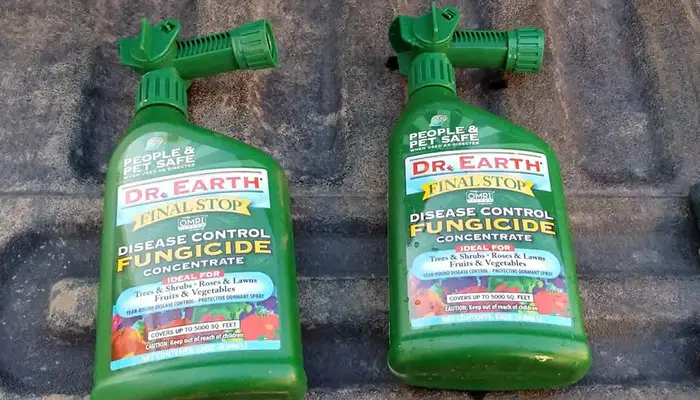
Dr. Earth has always been my favorite brand because of its 100% hand-crafted blend. Since 1991, Dr. Earth has provided us a lot of premium-quality pesticides & fertilizers that benefit our garden. That’s why we are going to check out another one today-
Active Ingredient
Dr. Earth Final Stop Disease Control Fungicide is OMRI listed for organic use. Why won’t that be? They trusted essential vegetable oils as active ingredients, which are 100% natural & organic.
The fungicide contains 0.06% Rosemary oil, 0.05% Clove Oil & 0.05% Peppermint Oil. The rest of the amount is inert ingredients including Lecithin, Water & Glycerin.
Mode of Action
All three essential oils preserve antifungal nature & repel a further attack of fungi & insects, plus some extent of bacteria also. The mode of action of these oils is basically through contact. Oils coat the fungal spore or the fruiting body, creating suffocation & eventual death.
Key Features
Fungicides normally exclude fungal attacks & the spreading in plants. Dr. Earth does the same by controlling powdery mildew, rust, black spot, peach leaf curl, shot hole, leaf blotch, scab, dollar spot, brown rot, fusarium blight, botrytis, downy mildew, scab anthracnose, phytophthora blight, and other plant diseases.
But that’s not all. It also provides minerals to your powdery mildew-affected plant to recover disease damages. Cool, right?
Additionally, routine spraying of this fungicide will ensure year-long protection from powdery mildew & other diseases. Plus, it is also an effective dormant spray that ensures the disease-free growth of plants.
However, seeing all these amazing features, you tell me, if anyone asks me what is the best organic fungicide for Powdery Mildew, should I suggest this fungicide or not? I think I should.
Applying Procedure
It is a Ready-To-Use fungicide. So, no measuring, no mixing. Just shake & apply. This fungicide also has a concentrated version. You can use it also but you may have to dilute it first.
9. Safer Garden Fungicide Concentrate
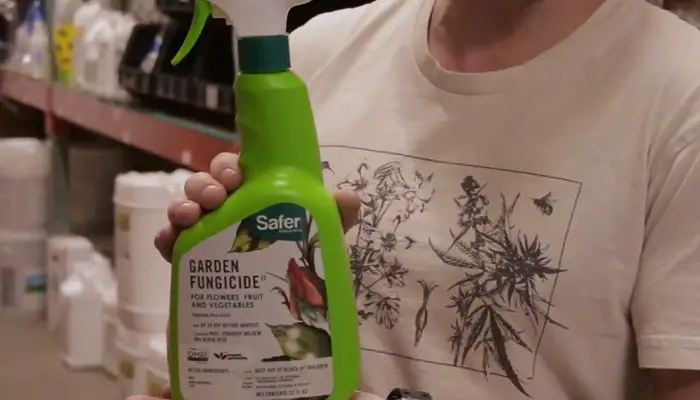
“We love the Earth and we love gardening. Above all else, we strive to be stewards of our environment.”- Over the past 30 years, the Safer brand has been embarking on this motto & the result- high-quality premium pesticides.
Active Ingredient
Safer Brand Garden Fungicide for flowers, fruit & vegetables is an organic pesticide that uses naturally occurring sulfur(12%) to prevent & control Fungal diseases like Powdery Mildew.
Mode of Action
Sulfur works through contact mode. When the fungicide comes into contact with the fungal spores or fruiting body, it interferes with the respiration of fungal cells & gradually kills the disease-spreading spores.
So, whether it is Powdery Mildew, Black Spot, or Rust, this fungicide is equally effective against all of them.
Key Features
Fungi need precise environmental conditions to live and grow. But Garden Fungicide with its amazing formula attacks these fungal diseases by forming a repellent environment for disease growth. And that ultimately leads to death & also reduces the spreading of spores.
Since it is an organic & natural fungicide, you can use it on the day before harvesting the edibles without any hesitation. Plus, a single bottle can dilute up to four gallons for long-term use. Economical, isn’t it?
Applying Procedure
Here’s a short list of application rates for Powdery Mildew of different plants-
For Roses & Potatoes, 1-gallon mixture per 350 sq. ft.
For Beans & Peas, 1 gallon per 250 sq. ft.
For Cucumber & Squash, 1-gallon per 600 sq. ft.
For Strawberries, 1 gallon per 300 sq. ft, etc.
However, before applying, shake properly & read the product label thoroughly. You may have to reapply every 7-10 days.
10. Scotts DiseaseEx Lawn Fungicide
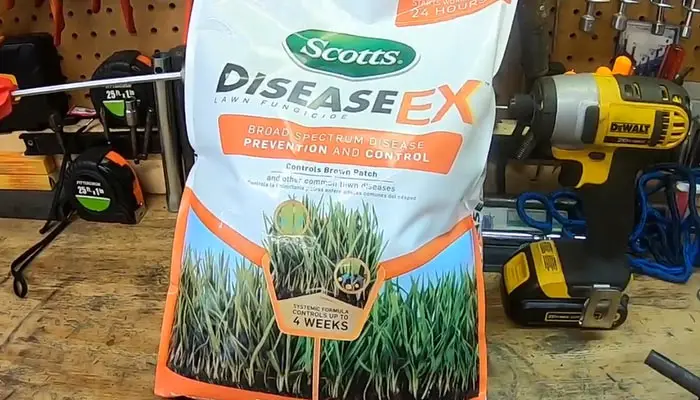
So far, I have been focusing on Powdery Mildew of garden plants like flowers, fruits & all. But my last recommendation is an ideal fungicide that can relieve your lawn from Powdery Mildew. So, without further ado, let’s check out-
Active Ingredient
Scotts DiseaseEx Lawn Fungicide contains 0.31% Azoxystrobin & it is the active ingredient of this fungicide. Azoxystrobin is a widely used organic compound to cure & prevent fungal diseases in plants.
Now, only a tiny portion of the blend is organic but most inert ingredients are of inorganic sources. That’s why DiseaseEx is considered more synthetic than organic.
Mode of Action
Azoxystrobin possesses a systemic mode of action. After application, the fungicide comes in contact with the surface dweller & some moments later, the fungicide gets absorbed inside the plant tissue to start working internally.
So what actually happens is, Azoxystrobin chokes out fungi by hindering the activity of the electron transport chain & which restricts fungal spores from germinating and pauses the growth process of the fungus.
Key Features
The fungicide renders a first acting broad-spectrum control & prevention service of fungal diseases for a better & greener lawn. It is able to cure almost 26 types of lawn diseases like Brown Patch, Powdery Mildew, Red Thread, Anthracnose, Leaf Spot, Pink Patch & many more.
Plus its systemic action prevents it from washing away because of rain & ensures full proof protection for up to 4 weeks.
Applying Procedure
Pour the granules on the spreader. Set the spreader according to your lawn’s requirements to prevent or cure the disease. Generally, for Scotts Drop Spreader, the preventive rate is 4 & the curative rate is 5.5.
How To Choose The Fungicide For Powdery Mildew- Buying Guide
Choosing the perfect fungicide to get rid of Powdery Mildew is easy if you follow some basic screening processes. Let me outline it a bit-
Plant Type
This is an important factor when choosing a pesticide for your plant. My motto is, I am not going to use synthetic chemicals or any kind of toxic chemical on a plant that has edible parts.
That’s why, for flowers, trees, landscaping vines, and lawns- I am okay with synthetic fungicides. But for fruits & vegetables, I suggest using organic & natural fungicides.
Stage of Powdery Mildew
Well, according to the stage of the disease, you have to pick the right one among the following two types of fungicides-
Preventive / Contact Fungicide
Contact fungicides only kill the fungus that dwells on the surface of leaves, flowers, stems, fruits, etc. Such fungicides can not kill the funguses that travel through the vascular system of the plant tissue.
That’s why, if Powdery Mildew hasn’t raised its ugly head yet & you want to spray some fungicide beforehand, contact fungicides are best.
Curative / Systemic Fungicides
Systemic fungicides get absorbed by the plant tissue, kill the internal culprits & prevent further fungal attacks. In a sense, Systemic fungicide is more effective. It can both cure & prevent the disease, while Contact fungicides can mostly prevent it rather than curing it.
Most of the time, growers use Systemic Fungicides when they couldn’t give enough time to take preventive measures, then the plant gets affected by Powdery Mildews.
Other Issues
Some more factors can also be considered while choosing. For example, some prefer granular fungicides, some prefer concentrated ones while some others prefer Ready-To-Use fungicides.
Not only that, but you can also look for special features. Many top branded products work as both insecticides & fungicides & who doesn’t love a bonus?
Home Remedy For Powdery Mildew
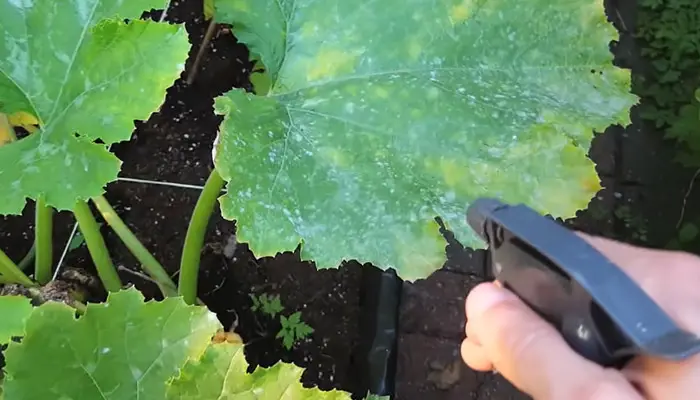
Powdery Mildew is so common that, for a long time, gardeners have been looking for a natural remedy for it. In this way, you can treat your edibles, flowers, etc with natural products with 0% chemical toxicity & also you can save some money. So, here is a very effective DIY Powdery Mildew Spray for you-
Ingredients-
- Neem Oil
- Liquid Soap
- Water
Procedure-
- Take 1 gallon of water in a bucket.
- Add 2 teaspoons of Neem oil to it.
- Add 1 teaspoon of liquid soap to the water.
- Shake or mix it properly. You have your Homemade Powdery Mildew Spray.
What is Powdery Mildew?
Almost every type of plant on this planet is susceptible to Powdery Mildew. Ornamentals, trees, fruits, vegetables, flowers, lawns, whatever it is, Powdery Mildew is common. But that doesn’t make it any less deadly.
We often ignore things that happen to us more frequently. But that’s not what you do in the case of Powdery Mildew. However, Powdery Mildew is a fungal disease. The responsible fungi can attack approximately 10,000 species of plants. Can you believe it?
Disease Mechanism
Powdery Mildew fungi are obligate biotrophs. That means they obtain their nutrients from the living cells of their host plants through specialized feeding organs called haustoria.
So, Powdery Mildew fungi never preserve an intention to kill the host plant instantly because they can’t live without a living cell.
Symptoms
The best time for Powdery Mildew growth is late spring or early summer. During this time, the evenings remain cool and humid, but the days start to get warm.
The first symptom that breaks out is raised blister-like areas on the upper leaf surface & causes leaf curling. You will notice white circles around the leaves, flowers, petals, stems, I mean, it can be anywhere, not necessarily on leaves.
If you by any chance miss this symptom, the next one would definitely catch you. In this stage, the whole leaf surface gets covered with a white powdery substance & which is the prime symptom. After that, you will notice gradual yellowing of leaves, distorted fruits, petals & such.
Treatments
- Nothing is more effective than applying an effective fungicide as a preventive measure. No matter if you are using a preventive or a curative fungicide, once established, the fungal attack is hard to get rid of. So, take care of your plants during the particular time of the year, when fungal attacks occur more.
- Another preventive measure could be using a disease-resistant plant variety to grow.
- Give your plant enough space so that air would flow easily. Prune them if needed.
- Provide water to your plants very carefully so that no splashing occurs. Most of the time, during watering, fungus moves from soil to plant with the help of water splash.
Frequently Asked Questions
Is Powdery Mildew Systemic?
It is a debatable question because nowadays, many growers think that Powdery Mildew may have a systemic effect. They believe the spores move into the vascular system of plant cells & move forward. But so far, there is no scientific proof about that. That’s why, till now, Powdery Mildew is not Systemic.
Is Powdery Mildew Harmful To Humans?
Humans are not the host of Powdery Mildew. So it is not harmful directly. You can touch it & then wash your hands obviously. But indirectly, Powdery Mildew reduces the yield of human food & this way, it is harmful to mankind.
Can Powdery Mildew Be Cured?
Powdery Mildew is curable if you take curative measures just after the symptoms break out. But too late means too late. You may have to remove the whole plant to save others. So, keep an eye on that.
Does Milk Get Rid Of Powdery Mildew?
Absolutely. Generally, after spraying, proteins in the milk combine with the sun to form a brief antiseptic effect & causes the burning of any fungi present on the surface. Thus milk spray can relieve your plants from Powdery Mildew attacks.
Does Powdery Mildew Stay In The Soil?
Yup, Fungal spores of Powdery Mildew can overwinter in the soil. That’s why the first preventive measure of Powdery Mildew is keeping the garden clean, fresh & free of debris & wastes.
What Are The Symptoms Of Powdery Mildew?
The common symptoms of Powdery Mildew are yellowish leaves, white spots, white powdery substance all over the surface & sometimes upward leaf curling.
Does Neem Oil Get Rid Of Powdery Mildew?
Yes, why not? Neem oil can coat the fungal body & lead to death by creating suffocation. Moreover, neem oil is also a superb insecticide for home gardens.
Can You Use Hydrogen Peroxide On Powdery Mildew?
Hydrogen Peroxide directly attacks the fungi responsible for Powdery Mildew. It breaks down the essential components like DNA & Protein & leads to gradual death. So, you can definitely use it.
Does Sevin Dust Get Rid Of Powdery Mildew?
Normally Sevin Dust is only effective against insects & does not cure fungal attacks. But if it is combined with sulfur, there’s a chance that it can control Powdery Mildew too
Final Words
Do you know what those white powdery substances are? These are millions of microspores that are going to spread & cause Powdery Mildew! Oh, Man! But we don’t have to worry about that, right?
However, I kept all the related factors in my mind while making the fungicide list. I studied customer reviews & the whole mechanism of the product & then narrowed my list to the 10 best fungicides for Powdery Mildew.
Hopefully, my work will save you some time & make your research a bit easier. Thanks for stopping by.

